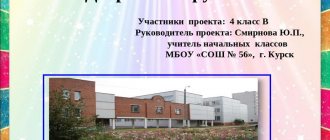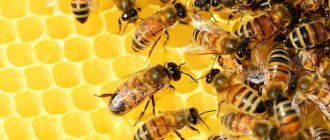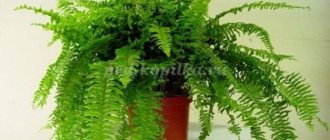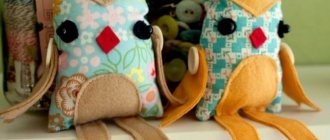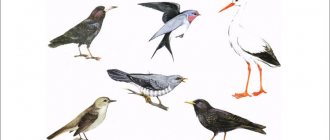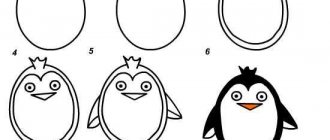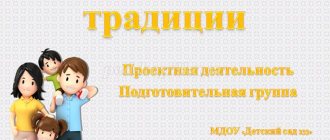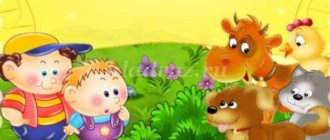Project “Birds are our friends” (preparatory group)
Yulia Kultysheva
Project “Birds are our friends” (preparatory group)
MK preschool educational institution Pavlovsky kindergarten No. 8
Educator: Kultysheva Yu. Yu.
Project activities with children in the preparatory group for school
Theme: “ Birds are our friends ”
Project type : educational
Project participants : children of the preparatory group , group , parents of students
Project implementation period : long-term
Relevance
Children need to be given basic knowledge about nature from an early age and maintained an interest in learning about the world around them. To evoke aesthetic experiences, the ability to empathize with living beings, that is, to realize that we do not have the right to destroy what nature has created, we are people, part of nature; by destroying nature, we destroy ourselves. In a word, we instill in children’s minds a sense of the world as a home, showing how the inhabitants of the house, planet Earth, get along and influence each other.
A preliminary diagnosis showed that children have insufficient knowledge about the life of birds , what benefits birds harmful for , and what is useful.
Therefore, it was decided to deepen children’s knowledge about the life of birds through educational, joint productive activities, connection with Russian folk customs and rituals, and involving parents in the work.
Forms of work: GCD, observations, games, conversations, storytelling, viewing, excursions, productive activities, work with parents.
The goal of the project : to expand children's knowledge about the birds of their native land , their lifestyle and behavior, as well as to cultivate a caring attitude towards feathered friends .
Tasks:
• consolidate children's knowledge about the importance of birds in people's lives ;
• conduct bird observations in our region ;
• develop cognitive interest and curiosity in the process of observing the habits of birds ;
• clarify and systematize children's ideas about wintering and migratory birds ;
• develop children’s coherent speech, generalize and clarify children’s vocabulary on the topic;
• create a desire to help winged friends in the winter season ;
• cultivate a careful and caring attitude towards birds;
•Develop creative abilities: teach children to draw,
• sculpt, construct birds from their component parts using various materials
Expected results:
• Children's learning about birds .
• Development of children's curiosity, creativity, cognitive activity, and communication skills.
• Development of an active, independent, creative personality in children.
• Develop the ability to draw conclusions by establishing cause-and-effect relationships between natural objects.
• -Involving parents in joint activities with children and the teacher.
• Improving the subject-development environment on the project
Preliminary work:
bird watching (where they live, what they eat)
— search work on the selection of illustrations, books on the topic “ birds ”
Project implementation stages :
Stage I: preparatory
•Creation of necessary conditions for project
•Advanced project
•Development and accumulation of teaching materials
Stage II – basic (practical)
• Project
•Introduction into the educational process of effective methods and techniques to expand preschoolers’ knowledge about birds .
Stage III - final
•Organization and participation of parents in the exhibition bird feeder ”
.
•design of the exhibition “ Birds are so different ”
•Prepare the result of the project in the form of a photo report .
Project implementation :
1.Cognitive development:
•excursion around the territory of the kindergarten;
•excursion to the forest
•observation and comparison of birds at feeders , area
•observation of rare birds (green woodpecker, nuthatch)
•observation - what sounds do birds
•counting different birds on the site ,
•conversations about birds , NOD: “ Birds are our friends ”, “The amazing world of birds ”, “Wintering birds ”, “Migratory birds ”, “Feathered neighbors”, KVN “Our feathered friends ”, “ Birds of our region ”
• compiling the album “ Birds of our region ”
•acquaintance with the folk calendar, discussion of folk signs
•considering problem situations
•observation and comparison of tracks in the snow
•review of encyclopedias, magazines
2. Speech development and reading fiction:
•design of an exhibition of books and illustrations about the birds of our region
•selection of illustrations depicting birds and design of the albums “Wintering Birds ”
, “
Birds “
•writing stories about birds
•didactic, word games
•learning poems, tongue twisters, nursery rhymes, rhymes, calls about birds , reading fairy tales and stories on the topic of the project
•theatrical activities
•looking at paintings
•an evening of riddles about birds .
•Listening to the audio material “Voices of Birds ”
•finger gymnastics
3. Productive activity:
•drawing “wintering birds ”, “ Birds in spring ”, “flock of sparrows”, “white-sided magpie”, “forest doctor”
•design of the collage “Feathered Friends ”
;
•applique “ Birds at the feeder ”
, “Birdhouse for a starling”, “Titmouse birds”, “Bullfinch on a rowan branch”
•coloring birds in coloring books
•modeling “ Birds of our site ”
•Manual labor. bird feeders from boxes and plastic bottles.
•Exhibition of drawings “Our feathered guests”
4. Experimentation
•experience “Which material is more resistant to moisture for the construction of a feeder”
;
•experience with feathers “Why birds plumage does not get wet when it rains or swims.”
5.Game activity:
. didactic, plot-role-playing, verbal, construction, directing, moving, theatrical;
6.Design:
•constructing a nest from twigs,
bird feeders from different materials
•design from paper “Bullfinch”, Small Bird”
7. Working with parents.
Consultation for parents “Know and be able to”, “Feed the birds in winter ”, competition – bird feeders ”
The project lasted from autumn to spring. preparation was made for it . The children received a lot of educational material.
The teachers managed to involve not only students, but also parents project Parents and children made bird .
The project contributed to the development of the creative and intellectual abilities of the pupils: the children drew a lot, sculpted birds and made applications on this topic.
Children looked at illustrations and albums about birds , expanding their horizons.
The children willingly fed the wintering birds . They treated the birds . And the birds were happy , tits and sparrows flocked from all sides, a spotted woodpecker flew in every day, and sometimes a green woodpecker and a nuthatch. And this year for the first time I came running to eat squirrels at the feeders. Having been observing birds for several years , we noticed that by replenishing the feeders in the same place and at the same time, the birds got used to constant feeding places and arrived at the same time.
I believe that the project has achieved its goal . Children have developed an initial caring attitude towards birds .
Watching birds gives children and adults great pleasure and joy.
We get the opportunity to instill in children a caring attitude towards nature through caring for birds .
Used Books:
1. 3. O. A. Voronkevich. Welcome to ecology. St. Petersburg, Childhood-Press. 2010
2. T. D. Nuzhdin “Encyclopedia - a miracle everywhere” - World of Animals and Plants
Yaroslavl, Development Academy, 1988.
3. L. P. Molodova “Moral and environmental education of older preschoolers. Mn: LLC “Asar”, 2001
4.
5. Shvaiko G.S. Classes on visual activities in kindergarten.
6. Lykova I. A. Visual activities in kindergarten. Senior and preparatory groups planning , notes, methodological recommendations.
8. Bandarenko T. M. “Ecological activities with children 5-6 years old” Voronezh: Shopping Center “Uchtel” 2002
9. Shorygina T. A., Birds . What are they? A book for educators, tutors and parents. – M.: “Publishing house GNOM and D”
, 2000.
Educational lesson Topic: “Birds are our friends”
Puzzles:
1. Gray little lump: Chip-chirp - he’s very cold! Sun, come out quickly! Who's waiting for warmth? (Slide Sparrow)
2. The yellow belly is the sparrow’s friend. (Slide Tit)
3. A strong, big bird, not even afraid of a cat!.. A very important person - Black and gray. (Crow Slide)
Educator: - How can you call these birds in one word? (wintering)
- Why are they called that? (they don’t fly anywhere, they spend the winter in the city)
—What do birds eat in winter? (seeds, rowan berries)
—What is worse for birds in winter than cold or hunger? (hunger)
4.Flies to us with warmth, Having traveled a long way, Sculpts a house under the window from grass and clay. (Swallow slide)
Educator. Guys, does Swallow spend the winter with us?
Children: no
Educator: Is this a migratory bird?
Children: (….)
Educator: Guys, let’s play the game “Bird’s Canteen”.
You will be the chicks you want, choose a picture for yourself. (A set of small pictures depicting birds according to the number of children is offered.)
And here (shows) there will be a bird feeder, but everyone doesn’t need to fly, I will read a poem, and when you hear your name of the bird, then feel free to fly to the feeder. The game is played, accompanied by the verse:
We made a feeder.
We opened a canteen
The tits came to visit us. (Children - tits - come to the center.)
And then, bullfinches. (Children - bullfinches - come to the center.)
And out of nowhere a crow jumped from a branch. (Children come out - crows.)
And in the neighboring yard, a flock of brave sparrows also flew in.. (Children come out - sparrows.)
Only the dove didn’t arrive; it ate crumbs in the snow. (Children are pigeons.)
There was general fun!
Educator: Well done, guys. Everyone remembered their birds and arrived at their appointed time, they were not mistaken.
Educator: Well, our lesson has come to an end. Let's say goodbye to our guests.
Conclusion.
- Who came to us?
- For what? (wanted to learn about birds).
— What did you learn in class today? (We learned that all birds are different, but they have something in common - a beak, feathers, wings, a tail.) But not everyone who has wings is a bird. Guys, now we are going to go for a walk and what treats will we take for the birds? In winter, guys, don't forget to take care of our little friends.
Today in group No. 17 there was an open display of educational activities on the topic: “Birds are our friends.” The main goals and objectives of the lesson are to cultivate a kind, caring attitude towards feathered friends. To form a cognitive interest in the environment: teach children kindness; teach them to take care of birds, watch them, and experience the joy of knowing that they can save birds from death. Give children basic knowledge of what they feed birds in winter. Clarify ideas about winter as the season most unfavorable for the life of plants and animals in nature.
